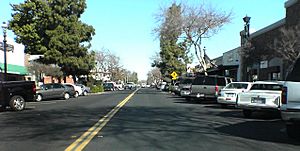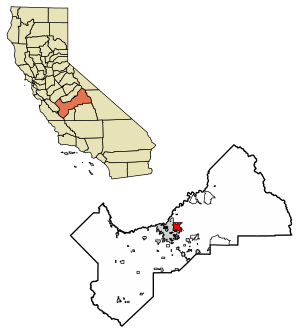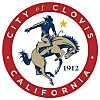Clovis, California facts for kids
Quick facts for kids
Clovis, California
|
|||
|---|---|---|---|

Pollasky Avenue, Old Town Clovis
|
|||
|
|||
| Motto(s):
"Gateway to the Sierras"
|
|||

Location of Clovis in Fresno County, California
|
|||
| Country | |||
| State | |||
| County | Fresno | ||
| Incorporated | February 27, 1912 | ||
| Named for | Clovis M. Cole Clovis Station |
||
| Government | |||
| • Type | Council–manager | ||
| Area | |||
| • Total | 25.91 sq mi (67.10 km2) | ||
| • Land | 25.79 sq mi (66.79 km2) | ||
| • Water | 0.12 sq mi (0.31 km2) 0% | ||
| Elevation | 361 ft (110 m) | ||
| Population
(2020)
|
|||
| • Total | 120,124 | ||
| • Rank | 46th in California 221st in the United States |
||
| • Density | 4,657.95/sq mi (1,798.44/km2) | ||
| Demonym(s) | Clovisian | ||
| Time zone | UTC−8 (Pacific) | ||
| • Summer (DST) | UTC−7 (PDT) | ||
| ZIP codes |
93611–93613, 93619
|
||
| Area code | 559 | ||
| FIPS code | 06-14218 | ||
| GNIS feature IDs | 1656303, 2409488 | ||
Clovis is a city in Fresno County, California, United States. It started in 1890 as a stop for the San Joaquin Valley Railroad. A group of Fresno business people and a railroad investor named Marcus Pollasky helped create it.
The railroad bought land from two farmers and named the station after one of them, Clovis Cole. Pollasky then built a town on the same spot, also called Clovis.
In 1894, a special flume for moving lumber was finished. This helped the area around Clovis Station grow, with a lumberyard and sawmill being built. Clovis officially became a city in 1912.
Today, Clovis celebrates its history as an old American town. It is famous for its rodeo, the historic Old Town Clovis area, and its motto, "Clovis – A Way of Life."
In the 2020 census, Clovis had a population of 120,124 people. The city is about 6.5 miles (10.5 km) northeast of downtown Fresno. It sits at an elevation of 361 feet (110 m) above sea level.
Contents
History of Clovis
The city of Clovis began as a stop for trains carrying goods on the San Joaquin Valley Railroad. This railroad was started on January 15, 1890, by business people from Fresno and a railroad investor named Marcus Pollasky.
Construction of the railroad began in Fresno on July 4, 1891. By October of that year, it reached the farms of Clovis M. Cole and George Owen. The railroad bought land from both farmers and built tracks along the border between their properties. They agreed to build a station on Owen's side of the tracks and name it "Clovis" after Clovis Cole.
How the Town Was Planned
Later, Cole and Owen sold more land to Marcus Pollasky to build a town. A civil engineer named Ingvart Tielman mapped out the town on December 29, 1891. The first streets in the town were named after the railroad's leaders and investors. Pollasky named the town "Clovis" after the station.
The railroad tracks were finished up to Hamptonville (now Friant), which was about 26 miles (42 km) from Fresno. Hamptonville was even called "Pollasky" for a while. A big celebration was held there in November 1891 to mark the completion of the tracks. The railroad officially started running in January 1892.
Railroad Challenges and Changes
The first year the railroad operated, the country faced a tough economic time. Farmers struggled to sell their crops, and many banks and railroads failed. The San Joaquin Valley Railroad couldn't make enough money to pay its debts. So, it was rented out to the Southern Pacific Railroad and then bought by them in 1893. By cutting back on train schedules and costs, Southern Pacific managed to make a small profit.
The Lumber Industry's Impact
Around the same time the railroad was being planned, a group of lumber business people from Michigan bought huge areas of timber in the Sierra Nevada Mountains. This was about 75 miles (121 km) northeast of Fresno. In 1891, they started the Fresno Flume and Irrigation Company.
They built a dam across Stevenson Creek to create a lake. This lake helped them move freshly cut timber to a mill next to the lake. Then, they built a 42-mile (68 km) long, 25-foot (7.6 m) high, V-shaped flume. This flume carried rough-cut lumber by water to a planing mill located east of the Clovis railroad station. Today, the Clovis Rodeo and Clark Intermediate School are on that site. The lumber mill had its own small train tracks to move lumber around and connect with the main railroad.
Growth of the Town
The completion of the lumber flume and the start of the mill in 1894 helped the area around Clovis Station grow a lot. Employees of the lumberyard built homes nearby. Soon, there was a need for businesses, churches, and schools, and the town began to form. Clovis got its first post office in 1895. By 1896, a newspaper reported that the town had almost 500 citizens.
Clovis officially became a city in February 1912. The main streets in the town center were named after the railroad's officers. Fulton Street, for example, was later called Front Street, then Main Street, and is now Clovis Avenue.
Clovis Today: A Western Town
The lumber mill burned down in 1914 and was never rebuilt. The land is now home to Clark Intermediate School and the Clovis Rodeo Grounds. Clovis has a long history as a western town, known for its slogan, "Clovis – A Way of Life."
Since 1914, the Clovis Rodeo has been held every year on the last weekend in April. It includes a parade on Saturday morning, followed by rodeo events that afternoon and all day Sunday. Other events that add to the "Clovis way of life" include Big Hat Days, ClovisFest, and the weekly Friday Night Farmer's Market, which runs from mid-May to mid-September.
The last building built by the railroad that is still standing is a depot. It is now located near where the original Clovis Station was. In 1999, it was moved to its current spot in the town center, at the corner of Clovis Avenue and Fourth Street. Local businesses and contractors helped restore it.
Many buildings in the old town center have been updated. Older shops on Clovis Avenue, the main street, have been restored. New buildings are designed to look like those from the early 1900s. This historic area is now known as "Old Town Clovis."
Geography and Location
| Weather chart for Clovis, California | |||||||||||||||||||||||||||||||||||||||||||||||
|---|---|---|---|---|---|---|---|---|---|---|---|---|---|---|---|---|---|---|---|---|---|---|---|---|---|---|---|---|---|---|---|---|---|---|---|---|---|---|---|---|---|---|---|---|---|---|---|
| J | F | M | A | M | J | J | A | S | O | N | D | ||||||||||||||||||||||||||||||||||||
|
2.2
54
32
|
2.1
61
41
|
2.2
66
45
|
0.8
74
48
|
0.4
83
55
|
0.2
91
61
|
0
97
66
|
0
95
65
|
0.3
89
60
|
0.7
78
52
|
1.1
63
42
|
1.3
53
29
|
||||||||||||||||||||||||||||||||||||
| temperatures in °F precipitation totals in inches source: Weather.com / NWS |
|||||||||||||||||||||||||||||||||||||||||||||||
|
Metric conversion
|
|||||||||||||||||||||||||||||||||||||||||||||||
Clovis covers a total area of about 23.28 square miles (60.29 km²), and all of it is land.
The city is located in the middle of Los Angeles and San Francisco. It borders Fresno in the San Joaquin Valley, which is known for its rich farmland. Clovis sits at the base of the Sierra Nevada Mountain Range. This range includes famous places like Yosemite, Kings Canyon, and Sequoia National Parks. Because of this, Clovis has been called "Gateway to the Sierras" since it became a city in 1912.
The land in this part of the San Joaquin Valley is quite flat. Clovis is about 355 feet (108 m) above sea level. Some areas of Clovis are in a 100-year flood zone, meaning there's a 1% chance of flooding in any given year.
Population and People
| Historical population | |||
|---|---|---|---|
| Census | Pop. | %± | |
| 1920 | 1,157 | — | |
| 1930 | 1,316 | 13.7% | |
| 1940 | 1,626 | 23.6% | |
| 1950 | 2,766 | 70.1% | |
| 1960 | 5,546 | 100.5% | |
| 1970 | 13,856 | 149.8% | |
| 1980 | 33,021 | 138.3% | |
| 1990 | 50,323 | 52.4% | |
| 2000 | 68,468 | 36.1% | |
| 2010 | 95,631 | 39.7% | |
| 2020 | 120,124 | 25.6% | |
| 2024 (est.) | 127,993 | 33.8% | |
| U.S. Decennial Census | |||
| Race / Ethnicity (NH = Non-Hispanic) | Pop 2000 | Pop 2010 | Pop 2020 | % 2000 | % 2010 | % 2020 |
|---|---|---|---|---|---|---|
| White alone (NH) | 46,186 | 55,021 | 57,916 | 67.46% | 57.53% | 48.21% |
| Black or African American alone (NH) | 1,207 | 2,360 | 2,993 | 1.76% | 2.47% | 2.49% |
| Native American or Alaska Native alone (NH) | 679 | 754 | 738 | 0.99% | 0.79% | 0.61% |
| Asian alone (NH) | 4,322 | 9,965 | 15,147 | 6.31% | 10.42% | 12.61% |
| Pacific Islander alone (NH) | 75 | 187 | 270 | 0.11% | 0.20% | 0.22% |
| Other Race alone (NH) | 131 | 153 | 666 | 0.19% | 0.16% | 0.55% |
| Mixed race or Multiracial (NH) | 1,992 | 2,677 | 5,800 | 2.91% | 2.80% | 4.83% |
| Hispanic or Latino (any race) | 13,876 | 24,514 | 36,594 | 20.27% | 25.63% | 30.46% |
| Total | 68,468 | 95,631 | 120,124 | 100.00% | 100.00% | 100.00% |
Population in 2020
The 2020 United States census showed that Clovis had 120,124 people. The population density was about 4,726.5 people per square mile (1,824.9/km²).
The racial makeup of Clovis was:
- 55.7% White
- 2.8% African American
- 1.4% Native American
- 13.0% Asian
- 0.3% Pacific Islander
- 11.8% from other races
- 15.1% from two or more races
People of Hispanic or Latino background made up 30.5% of the population.
Most people (99.6%) lived in homes. About 38.4% of households had children under 18. The average household had 2.84 people. The median age in Clovis was 36.1 years.
In 2023, the average household income was $100,360. The income per person was $43,774. About 7.4% of the population lived below the poverty line.
Economy and Jobs
Top Employers in Clovis
Many people in Clovis work for large organizations and companies. Here are some of the top employers in the city, based on a 2024 report:
| # | Employer | # of Employees |
|---|---|---|
| 1 | Clovis Unified School District | 5,228 |
| 2 | Clovis Community Hospital | 2,988 |
| 3 | County of Fresno | 1,874 |
| 4 | Walmart | 890 |
| 5 | City of Clovis | 767 |
| 6 | Wawona Frozen Foods | 735 |
| 7 | Anlin Industries | 526 |
| 8 | Costco | 435 |
| 9 | Target | 406 |
| 10 | Cen Cal Builders | 350 |
Shopping and Transportation
The Sierra Vista Mall is a large shopping center covering 78 acres (32 ha). It has stores like Target and Kohl's, a movie theater, and an indoor race track.
For getting around, Clovis Transit provides public transportation within the city. Some areas are also served by Fresno Area Express, which connects Clovis to Fresno.
Education in Clovis
Clovis has many schools and colleges.
Clovis Unified School District
The Clovis Unified School District serves students from elementary to high school.
- Elementary schools: Boris, Bud Rank, Cedarwood, Century, Clovis, Cole, Copper Hills, Cox, Dry Creek, Fancher Creek, Fort Washington, Freedom, Fugman, Garfield, Gettysburg, Jefferson, Liberty, Lincoln, Maple Creek, Mickey Cox, Miramonte, Mountain View, Nelson, Pinedale, Red Bank, Reagan Elementary, Riverview, Sierra Vista, Tarpey, Temperance-Kutner, Valley Oak, Weldon, Harold L. Woods, Red Bank
- Middle schools: Clark Intermediate, Kastner Intermediate, Alta Sierra Intermediate, Reyburn Intermediate, Granite Ridge Intermediate
- High schools: Buchanan High School, Clovis East High School, Clovis High School, Clovis West High School, Clovis North High School, Enterprise High School, Excel High School, Gateway High School
Colleges and Universities
For higher education, Clovis has:
- Clovis Community College
- San Joaquin College of Law
- California Health Sciences University College of Osteopathic Medicine
- California Health Sciences University College of Pharmacy
Public Libraries
The Fresno County Public Library operates the Clovis Regional Library, where you can find books and other resources.
Notable People from Clovis
Many talented people have come from Clovis, including:
- Ryan Beatty, a pop singer
- Connor Brogdon (born 1995), a baseball player for the Philadelphia Phillies
- Tyler Clutts, a former NFL fullback
- Chris Colfer, an actor known for Glee and author of Land of Stories books
- Terry Cooney, a former American League baseball umpire
- Colby Covington, a mixed martial artist and former UFC champion
- Zubin Damania, a doctor and founder of Turntable Health
- Bryson DeChambeau, a golf champion who won the U.S. Open in 2020 and 2024
- Jason Donald, a former MLB infielder
- Jordan Feliz, a Christian pop singer/songwriter
- Zack Follett, a former linebacker for the Detroit Lions
- Matt Giordano, a former American football safety and current physical education teacher
- Aaron Hill, an actor known for the TV show Greek
- Valarie Kaur, a filmmaker, civil rights activist, and Sikh leader
- Eric Kendricks, a linebacker for the Minnesota Vikings
- Daryle Lamonica, a former quarterback for the Buffalo Bills and Oakland Raiders
- Alysa Liu, a figure skater
- Sam Long (born 1995), a baseball player for the San Francisco Giants
- Mary Loveless, an immunologist
- Kendall Milton, a college football player for the Georgia Bulldogs
- Garrett Olson, a former MLB pitcher
- Jenna Prandini, a track and field athlete and Olympian
- PJ Raval, a filmmaker
- Aaron Ruell, an actor known for playing Kip in Napoleon Dynamite
- Kate Scott, a sportscaster for the Philadelphia 76ers
- John Taylor, a former wide receiver for the San Francisco 49ers
- Jason Von Flue, a professional mixed martial artist
- Justin Wilson, a professional MLB pitcher for the Cincinnati Reds
See also
 In Spanish: Clovis (California) para niños
In Spanish: Clovis (California) para niños
- Burrough Valley
- Tollhouse, California
- Shaver Lake






